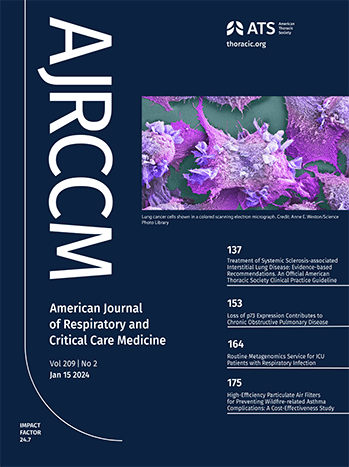elexaftor /Tezacaftor/Ivacaftor治疗至少一个F508del等位基因的囊性纤维化成人和青少年患者的长期安全性和有效性:一项3期开放标签扩展研究
IF 19.3
1区 医学
Q1 CRITICAL CARE MEDICINE
American journal of respiratory and critical care medicine
Pub Date : 2025-04-10
DOI:10.1164/rccm.202411-2231oc
引用次数: 0
摘要
临床和现实世界的研究表明,elexaftor /tezacaftor/ivacaftor (ELX/TEZ/IVA)对年龄≥12岁且至少有一个F508del等位基因的囊性纤维化(CF)患者有效且安全。目的:考虑到ELX/TEZ/IVA终身使用的可能性,评估ELX/TEZ/IVA的长期安全性和有效性。方法在这项3期、开放标签、单组扩展研究中,f508del -最小功能基因型(来自24周的母体研究445-102 [n = 399])或F508del-F508del基因型(来自4周的母体研究445-103 [n = 107])的参与者在192周内接受ELX/TEZ/IVA (ELX 200 mg每天一次,TEZ 100 mg每天一次,IVA 150 mg每12小时一次)。测量方法和主要结果主要终点是安全性和耐受性。ELX/TEZ/IVA的平均暴露时间为172.6周。大多数参与者的不良事件严重程度分为轻度(12.8%)或中度(60.7%)。18名参与者(3.6%)有不良事件导致停止治疗。在开始ELX/TEZ/IVA后,参与者的预测FEV1 (ppFEV1)百分比、囊性纤维化问卷修订呼吸域评分和体重指数持续增加,汗液氯化物浓度和肺恶化率下降;这些改善持续了192周。ELX/TEZ/IVA开始后,ppFEV1的平均年化变化率为0.02个百分点(95% CI, -0.14至0.19)。在这项为期192周的开放标签扩展研究中,ELX/TEZ/IVA是迄今为止CFTR调节剂最长的临床研究,总体上保持安全且耐受性良好。参与者的肺功能、呼吸症状、CFTR功能、肺恶化率和营养状况持续改善。估计ppFEV1的年化变化率表明,在4年的治疗期间,研究人群中没有肺功能丧失的证据。这些结果证实了ELX/TEZ/IVA在青少年和成人CF患者中具有良好的长期安全性和持久的疾病改善临床益处。临床试验注册可在www.CLINICALTRIALSgov, ID: NCT03525574。本文章由计算机程序翻译,如有差异,请以英文原文为准。
Long-Term Safety and Efficacy of Elexacaftor/Tezacaftor/Ivacaftor in Adults and Adolescents with Cystic Fibrosis and at Least One F508del Allele: A Phase 3, Open-Label Extension Study.
RATIONALE
Clinical and real-world studies show elexacaftor/tezacaftor/ivacaftor (ELX/TEZ/IVA) is efficacious and safe in people with cystic fibrosis (CF) ≥12 years of age with at least one F508del allele.
OBJECTIVES
Given the potential for life-long ELX/TEZ/IVA use, long-term safety and efficacy of ELX/TEZ/IVA was assessed.
METHODS
In this phase 3, open-label, single-arm extension study, participants with F508del-minimal function genotypes (from 24-week parent study 445-102 [n = 399]) or with the F508del-F508del genotype (from 4-week parent study 445-103 [n = 107]) received ELX/TEZ/IVA (ELX 200 mg once daily, TEZ 100 mg once daily, and IVA 150 mg every 12 hours) over 192 weeks.
MEASUREMENTS AND MAIN RESULTS
Primary endpoint was safety and tolerability. Mean exposure to ELX/TEZ/IVA was 172.6 weeks. Most participants had adverse events classified as mild (12.8%) or moderate (60.7%) in severity. Eighteen participants (3.6%) had adverse events that led to treatment discontinuation. After starting ELX/TEZ/IVA, participants had consistent increases in percent predicted FEV1 (ppFEV1), Cystic Fibrosis Questionnaire-Revised respiratory domain score, and body mass index, with decreases in sweat chloride concentration and pulmonary exacerbations rates; these improvements were maintained through 192 weeks. The mean annualized rate of change in ppFEV1 was 0.02 percentage points (95% CI, -0.14 to 0.19) after initiation of ELX/TEZ/IVA.
CONCLUSIONS
During this 192-week open label extension study, the longest clinical study of a CFTR modulator to date, ELX/TEZ/IVA remained generally safe and well-tolerated. Participants had sustained improvements in lung function, respiratory symptoms, CFTR function, pulmonary exacerbation rates, and nutritional status. The estimated annualized rate of change in ppFEV1 suggests no evidence of pulmonary function loss across the study population over the 4-year treatment period. These results confirm the favorable long-term safety profile and durable disease-modifying clinical benefits of ELX/TEZ/IVA in adolescents and adults with CF. Clinical trial registration available at www.
CLINICALTRIALS
gov, ID: NCT03525574.
求助全文
通过发布文献求助,成功后即可免费获取论文全文。
去求助
来源期刊
CiteScore
27.30
自引率
4.50%
发文量
1313
审稿时长
3-6 weeks
期刊介绍:
The American Journal of Respiratory and Critical Care Medicine focuses on human biology and disease, as well as animal studies that contribute to the understanding of pathophysiology and treatment of diseases that affect the respiratory system and critically ill patients. Papers that are solely or predominantly based in cell and molecular biology are published in the companion journal, the American Journal of Respiratory Cell and Molecular Biology. The Journal also seeks to publish clinical trials and outstanding review articles on areas of interest in several forms. The State-of-the-Art review is a treatise usually covering a broad field that brings bench research to the bedside. Shorter reviews are published as Critical Care Perspectives or Pulmonary Perspectives. These are generally focused on a more limited area and advance a concerted opinion about care for a specific process. Concise Clinical Reviews provide an evidence-based synthesis of the literature pertaining to topics of fundamental importance to the practice of pulmonary, critical care, and sleep medicine. Images providing advances or unusual contributions to the field are published as Images in Pulmonary, Critical Care, Sleep Medicine and the Sciences.
A recent trend and future direction of the Journal has been to include debates of a topical nature on issues of importance in pulmonary and critical care medicine and to the membership of the American Thoracic Society. Other recent changes have included encompassing works from the field of critical care medicine and the extension of the editorial governing of journal policy to colleagues outside of the United States of America. The focus and direction of the Journal is to establish an international forum for state-of-the-art respiratory and critical care medicine.

 求助内容:
求助内容: 应助结果提醒方式:
应助结果提醒方式:


